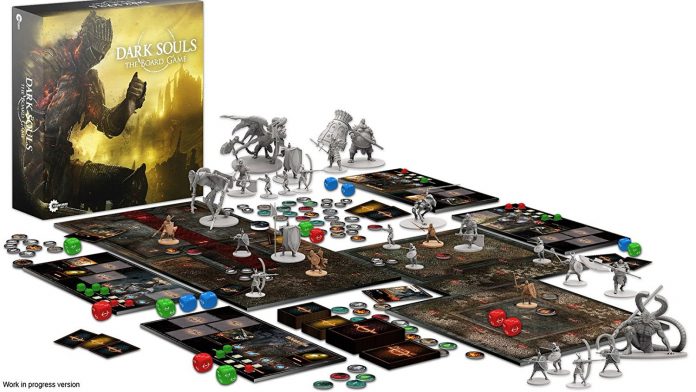When you pick up a board game box that weighs more than most cats, you know you’re in for one of two things: an in-depth and exciting game with many intricacies, or a dull slog through a gargantuan rulebook, and hours of gameplay that nobody completely understands. Thankfully, Dark Souls — The Board Game is much more of the former, and despite its intimidating appearance, provides an exciting adventure where most (though not all) of the rules are reasonably easy to learn and follow.
Based on the fantasy RPG video game series of the same name (primarily Dark Souls and Dark Souls III, because nobody really cares about Dark Souls II), the board game takes one to four players through a replica of a Dark Souls adventure. It’s got everything you’d expect: cautiously venturing out from bonfires, trying to outmaneuver teams of undead in close-quarters fights, tons of items and equipment to use, and trying, often unsuccessfully, to dodge away from massive, overpowering boss monsters.
Dark Souls — The Board Game is not a quick game. It is also a liar. The box features a hilarious misprint: the top of the box indicates a 60–90 minute playtime; the sides of the box all list 90–120 instead. The quibble doesn’t really matter, because all told, for a group of four first-time players, completing a game clocked in closer to seven hours. That’s 420 minutes, for those keeping score. Even if experience shortens the time needed for set-up and rule checking, it’s hard to imagine a future game running anywhere under three hours, and that’s assuming there are no major setbacks or bad luck.
And there will be setbacks and bad luck.
The Dark Souls games are certainly best known for their difficulty, and the board game adaption carries on the tradition. The game is wholly cooperative: players share all of their gear and “souls” (the currency of the Dark Souls world), and if even one of them falls in battle, the entire group is sent back to the start of the map to try again. Unlike the video games, though, retries are not unlimited: if you fail too often, it’s game over. While this is one of the few ways that the game differs from the key themes of the source material (where persistence and trial and error are entirely essential), it’s a necessary one to keep a sense of tension in the game, and that tension never lets up. Any fight could spell disaster, so every player must always be on their toes against the onslaught of foes.
The enemies are handled through game mechanics that indicate where they move and whom they target based on the players’ actions and locations. It takes a bit of getting used to, but within a short amount of time, most players should fully understand it, and be able to make tactical decisions based on knowing their enemy’s patterns. Boss monsters follow a similar mechanic, though with more complex and varied abilities. Because their rules are less common (during one game, there will be a minimum of eight fights against basic enemies — likely more — but only two against bosses) it can lead to confusion, but in a game with no competitive element, confusion isn’t nearly as much of a source of tension as when it’s one player versus another.
The meat of the game is its tactical combat, and it excels there: players always feel like they have options, but never like they have too many options, and the turns move quickly enough that nobody gets bored waiting for theirs, especially because players will naturally advise each other throughout the fight. Aside from combat, the game gives players a chance to upgrade their character’s gear (and the skills required to equip stronger items), which provides a nice break, and a chance to customize each of the four unique characters further to suit a player’s preferred playstyle. The only issue with this part of the game is that, because players share souls and gear, which are scarce at the start of the game, some groups may end up in debates about how best to spend the souls, or who gets to make use of the most powerful items. However, players who bear in mind that the game is cooperative and that they’re all defeated if even one falls, will do well by always strengthening the weakest link in the chain.
Finally, it would be a disservice to review Dark Souls — The Board Game and not acknowledge the components the game is made up of. Inside that incredibly heavy box is an intimidating assortment of dice, tokens, cards, boards, and miniatures. They’re all high-quality, heavy cardboard or solid plastic, showing that this was a game clearly built to last (although the plethora of tiny wooden cubes used to mark health and stamina are sure to go missing quickly). The miniatures in particular are impressive: while they’re not painted, they’re intricately detailed recreations of various characters from the Dark Souls games, with the larger bosses standing easily four or five inches tall. The sense of scale greatly adds to the epic, threatening nature of those encounters, and adds a lot to the game’s already carefully maintained atmosphere of constant tension.
Dark Souls — The Board Game might look scary and come from a series with a big reputation, but the game manages to maintain those elements while being fun, relatively accessible (as far as giant, complex games go), and constantly engaging… even as it stretches out for hours longer than advertised.
Jeff was The Cascade's Editor in Chief for the latter half of 2022, having previously served as Digital Media Manager, Culture & Events Editor, and Opinion Editor. One time he held all three of those positions for a month, and he's not sure how he survived that. He started at The Cascade in 2016.





